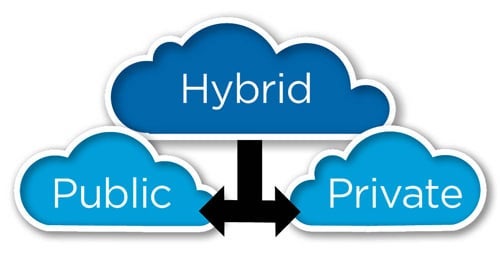Hybrid Cloud Storage provides flexibility in managing data storage & application workloads. Is Hybrid Cloud Storage right for you? Click here now.


It’s no surprise that hybrid cloud storage is growing. Hybrid cloud itself is an increasingly popular approach to deploying IT services. In fact, Gartner predicts that 90 percent of enterprises will be using hybrid infrastructure management capabilities by 2020.
What does this mean for your data storage strategy? First, let’s cover some basics about hybrid cloud.
Jump to: Is Hybrid Cloud Storage Right for Your Company? Key Issues in Hybrid Cloud Storage Security and Compliance ConcernsAs the term suggests, hybrid cloud is a mix of different IT environments that are used together to provide enterprises with flexible ways managing their data storage and running application workloads.
On one side there is the public cloud, an assortment of third-party IT offerings from cloud providers like Amazon Web Services, Microsoft Azure, IBM Cloud and Google Cloud Platform. On the other are private clouds and on-premises IT architectures.
The combination of the two, linked by a secure connection and working as one system, creates a hybrid cloud environment. This is key; simply using public cloud services and a private cloud independently doesn’t qualify as a hybrid cloud.
The systems must be linked and work in concert, often involving security, automation and orchestration technologies, along with the integration of on-premises and public clouds to deliver the desired results.

If it’s not already, it’s likely that hybrid cloud storage will be the default choice for companies.
Here are some factors to consider while considering a hybrid cloud storage environment.
If your organization is running low on physical data center space for storage, and a move or expansion is not an option, a hybrid cloud strategy may make a lot sense. Contracting with a public cloud provider with nearby facilities may be a good idea. They have already invested millions in building massive cloud data centers after all. These providers may help organizations maximize their existing investments, freeing up storage and compute capacity to make more room for mission-critical and high-value storage workloads.
Be forewarned, this still requires the talents of cloud-savvy IT professionals, so make sure your talent pool is prepared for the challenge. Although cheaper than outfitting a data center with new storage systems and servers, businesses must still be prepared to invest in software, services, appliances, servers, networking equipment and other hardware used to maintain reliable links to the public cloud.
One of the biggest draws of a hybrid cloud environment is its elasticity and the ability to extend or “cloud burst” or storage workloads to a public cloud provider when demand picks up. As a perk, overpaying for on-premises storage and servers that lay idle most of the time may be a thing of the past.
Of course, this unregulated behavior cannot be tolerated in a business environment, particularly one operating under strict compliance requirements for sensitive stored data.
A hybrid approach solves this by extending the authentication and security capabilities of a private cloud or on-premises environment to public cloud infrastructures. This allows “as a service” consumption models that blend the manageability and control of a local IT environment with the vast resources and sheer capabilities offered by public cloud providers. This adds business agility and more flexible IT operations – and greatly enhances your storage capacity.
Let’s look at some central issues involved with implementing a hybrid cloud storage strategy, with background to help you decide your strategy.
Even if a cloud provider’s data center is relatively close by and offers SSD-backed services and other high-performance storage options, it’s unlikely to beat the data transfer speeds of your own data center. Mission critical workloads with strict tolerances on data latency may not be a suitable match for hybrid cloud storage.
Ensuring data security and compliance across an entire hybrid cloud environment is all about alignment.
An enterprise’s internal security standards, policies and procedures must align with its public cloud provider’s security capabilities. Fortunately, most major cloud providers offer a wealth of encryption, authentication and other security controls and integrations to keep sensitive business information safe.
Likewise, the type of data you possess also has an impact on where you can store it without raising the ire of regulatory authorities.
If your organization handles health data and you’re considering moving at least some of it into a public cloud, the U.S. Health Insurance Portability and Accountability Act (HIPAA) is a factor. If credit card information is included in the user data that you plan on placing on the public cloud, complying with the Payment Card Industry Data Security Standard (PCI DSS) is a must. Have European users? The EU’s General Data Protection Regulation (GDPR) cannot be ignored.
Again, most major cloud storage providers are on the ball, offering guidance on aligning their offerings with the appropriate security and compliance controls to make certain they don’t run afoul of industry regulations.
Further Reading Public Cloud Storage Guide for Businesses Cloud Storage Management Managing Cloud Storage Migration
Enterprise Storage Forum offers practical information on data storage and protection from several different perspectives: hardware, software, on-premises services and cloud services. It also includes storage security and deep looks into various storage technologies, including object storage and modern parallel file systems. ESF is an ideal website for enterprise storage admins, CTOs and storage architects to reference in order to stay informed about the latest products, services and trends in the storage industry.
Property of TechnologyAdvice. © 2025 TechnologyAdvice. All Rights Reserved
Advertiser Disclosure: Some of the products that appear on this site are from companies from which TechnologyAdvice receives compensation. This compensation may impact how and where products appear on this site including, for example, the order in which they appear. TechnologyAdvice does not include all companies or all types of products available in the marketplace.